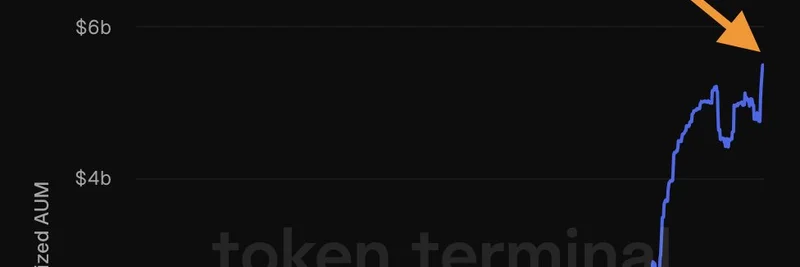If you've been keeping an eye on the blockchain space, you've probably noticed how real-world assets (RWAs) are making waves. But let's zoom in on tokenized funds—those blockchain versions of traditional investment funds that make everything from trading to ownership a breeze. Recently, Token Terminal dropped a chart that's turning heads, showing Ethereum absolutely crushing it in terms of assets under management (AUM) for these funds.
Understanding the Chart: Ethereum's Meteoric Rise
The visual from Token Terminal's tweet paints a clear picture. Starting from near-zero in 2023, the AUM for tokenized funds across various chains stayed relatively flat through much of 2024. Then, bam—2025 hits, and Ethereum's line (in blue) shoots up like a rocket, peaking at over $6 billion. That's not just growth; that's dominance.
For context, tokenized funds are essentially shares of investment portfolios turned into digital tokens on the blockchain. This allows for fractional ownership, instant settlements, and global access—perks that traditional finance can't match easily. AUM here refers to the total value of assets managed within these funds.
Ethereum's lead isn't subtle. While other chains like zkSync Era (red line, hovering around $1 billion), Solana (orange, much lower), and Arbitrum One (purple, barely registering) show some activity, they're dwarfed by Ethereum's surge. Chains such as Polygon, Avalanche, Aptos, Base, BNB Chain, OP Mainnet, Plume Network, and Ink are all clustered at the bottom, with minimal AUM growth.
This data aligns with broader trends we've seen in 2025. For instance, reports indicate that tokenized assets overall have ballooned to around $270 billion, with Ethereum capturing about 55% of that market share due to its robust smart contract ecosystem and widespread adoption of standards like ERC-20. But when it comes to specifically tokenized funds, Ethereum's market share jumps to around 65%, as noted in earlier Token Terminal updates from September 2025.
Why Is Ethereum Winning Big?
So, what's fueling this explosion? A big part is institutional heavyweights jumping in. Take BlackRock's BUIDL fund, for example—it's one of the standout tokenized funds on Ethereum and has seen its AUM swell to $600 million in recent months, driven by expansions across blockchains but rooted firmly in Ethereum's infrastructure.
Other factors include:
- Superior Liquidity and Network Effects: Ethereum's massive ecosystem provides unmatched liquidity, making it the go-to for funds that need reliable trading and integration with DeFi protocols.
- Regulatory Clarity: With spot Ethereum ETFs capturing billions in inflows (like the $3.8 billion in August 2025 alone), institutions feel more comfortable parking assets here.
- Innovation in RWAs: Tokenized funds are part of the larger RWA boom, projected to hit $235 billion in AUM by 2029 from about $4 billion earlier in 2025. Ethereum's developer tools and security make it ideal for this.
Comparatively, chains like Solana offer speed and low fees, which have made them hotspots for meme tokens, but they lag in attracting these high-value, institutional-grade funds. zkSync Era's second-place position suggests rollups are gaining traction, but they're still playing catch-up.
Implications for the Meme Token Ecosystem
At Meme Insider, we're all about meme tokens, so let's connect the dots. While tokenized funds might seem like the suit-and-tie side of crypto, their growth injects serious capital into the blockchain world—which can trickle down to the wilder, community-driven meme space.
For starters, more AUM on Ethereum means better overall liquidity. Meme tokens on Ethereum (think PEPE or older classics) could benefit from this institutional influx, potentially stabilizing prices and opening doors to hybrid products—like meme funds tokenized on-chain.
But here's the twist: Solana, a meme token powerhouse with hits like BONK and DOGWIFHAT, shows low AUM in tokenized funds. This highlights a divide—Solana excels in retail frenzy and fast transactions, but Ethereum's lead in RWAs could draw more developers and capital, indirectly boosting cross-chain meme projects or inspiring Solana-based funds.
Looking ahead, as tokenized funds grow (with projections of a 58-fold increase by 2029), expect spillover effects. DeFi-native issuers are catching up to giants like BlackRock, potentially creating opportunities for meme-inspired funds or tokenized meme portfolios. If you're a blockchain practitioner dabbling in memes, keep an eye on how these trends evolve—it could mean new ways to enhance your strategies and tap into institutional flows.
In short, Ethereum's tokenized fund dominance isn't just a win for ETH holders; it's a signal that crypto is maturing, blending tradfi with blockchain innovation. What do you think—will Solana or other chains close the gap? Drop your thoughts in the comments!


